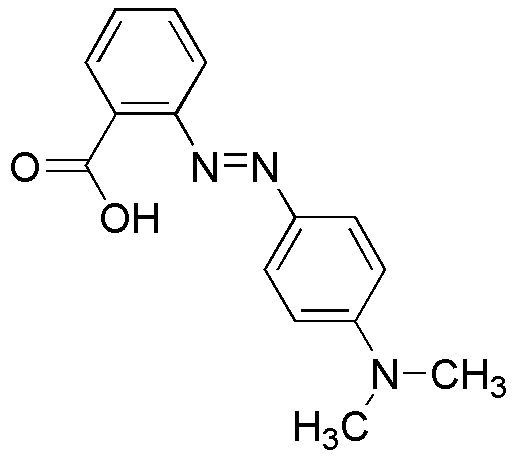Methyl Red free acid is widely utilized in research focused on:
- pH Indicator: Commonly used in titrations, it changes color at a pH range of 4.4 to 6.2, making it ideal for determining the acidity of solutions in laboratories.
- Biological Research: Employed in microbiological studies to differentiate between acid-producing and non-acid-producing bacteria, aiding in the identification of various microbial species.
- Textile Industry: Used as a dye in textiles, providing vibrant colors while being relatively easy to apply and fix, enhancing the aesthetic appeal of fabrics.
- Pharmaceutical Applications: Acts as a pH-sensitive dye in drug formulation, helping to ensure that medications maintain their stability and efficacy under varying pH conditions.
- Environmental Testing: Utilized in assessing water quality, where it helps indicate the acidity of water samples, contributing to environmental monitoring efforts.
General Information
Properties
Safety and Regulations
Applications
Methyl Red free acid is widely utilized in research focused on:
- pH Indicator: Commonly used in titrations, it changes color at a pH range of 4.4 to 6.2, making it ideal for determining the acidity of solutions in laboratories.
- Biological Research: Employed in microbiological studies to differentiate between acid-producing and non-acid-producing bacteria, aiding in the identification of various microbial species.
- Textile Industry: Used as a dye in textiles, providing vibrant colors while being relatively easy to apply and fix, enhancing the aesthetic appeal of fabrics.
- Pharmaceutical Applications: Acts as a pH-sensitive dye in drug formulation, helping to ensure that medications maintain their stability and efficacy under varying pH conditions.
- Environmental Testing: Utilized in assessing water quality, where it helps indicate the acidity of water samples, contributing to environmental monitoring efforts.
Documents
Safety Data Sheets (SDS)
The SDS provides comprehensive safety information on handling, storage, and disposal of the product.
Product Specification (PS)
The PS provides a comprehensive breakdown of the product’s properties, including chemical composition, physical state, purity, and storage requirements. It also details acceptable quality ranges and the product's intended applications.
Certificates of Analysis (COA)
Search for Certificates of Analysis (COA) by entering the products Lot Number. Lot and Batch Numbers can be found on a product’s label following the words ‘Lot’ or ‘Batch’.
*Catalog Number
*Lot Number
Certificates Of Origin (COO)
This COO confirms the country where the product was manufactured, and also details the materials and components used in it and whether it is derived from natural, synthetic, or other specific sources. This certificate may be required for customs, trade, and regulatory compliance.
*Catalog Number
*Lot Number
Safety Data Sheets (SDS)
The SDS provides comprehensive safety information on handling, storage, and disposal of the product.
DownloadProduct Specification (PS)
The PS provides a comprehensive breakdown of the product’s properties, including chemical composition, physical state, purity, and storage requirements. It also details acceptable quality ranges and the product's intended applications.
DownloadCertificates of Analysis (COA)
Search for Certificates of Analysis (COA) by entering the products Lot Number. Lot and Batch Numbers can be found on a product’s label following the words ‘Lot’ or ‘Batch’.
*Catalog Number
*Lot Number
Certificates Of Origin (COO)
This COO confirms the country where the product was manufactured, and also details the materials and components used in it and whether it is derived from natural, synthetic, or other specific sources. This certificate may be required for customs, trade, and regulatory compliance.


